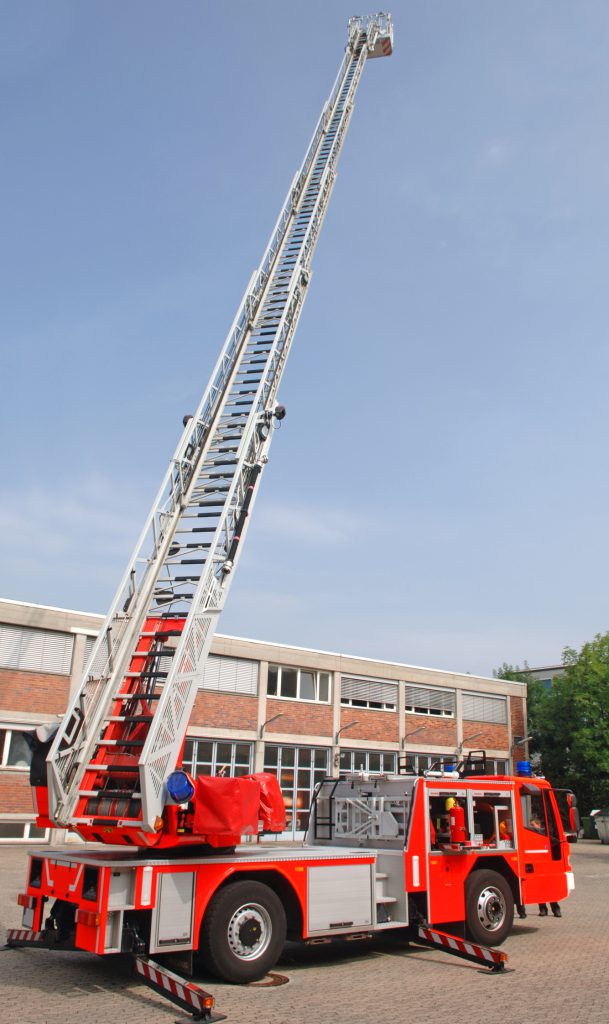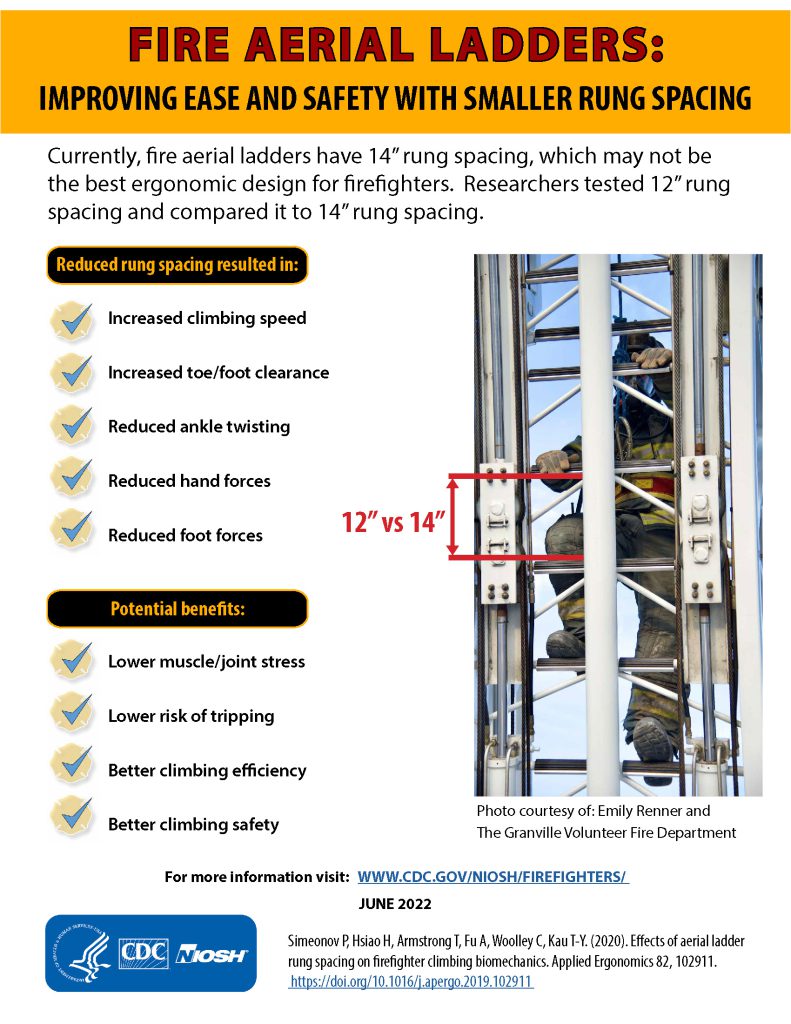Research Shows Benefits of Reduced Aerial Ladder Rung Spacing
Posted on by
As a critical part of their job, firefighters often climb aerial ladders up to 30 meters (or 98 feet) long and positioned at various angles. Aerial ladders are mechanically-operated, long, extendable ladders mounted on fire trucks and are used to reach high places for extinguishing fires and rescue operations. While climbing, firefighters typically wear heavy protective equipment and may also carry additional equipment related to fighting fires or rescuing occupants from burning buildings. They may work in extremely cold or hot environments.
In 2021, nearly 32% of the estimated 60,450 firefighter line-of-duty injuries occurred during fire-ground operations. Overexertion and strain (25%) and fall, jump, slip, or trip (24%) were the two leading causes of fire-ground injuries.[1] Climbing is a physically demanding and fatiguing task that can reduce work performance and increase risk of fall incidents and musculoskeletal injuries.[2] The firefighter community recognizes aerial ladders as a significant source of falls and overexertion injuries.
Measuring the Effects of Rung Spacing
Researchers from the National Institute for Occupational Safety and Health (NIOSH), in partnership with the University of Michigan’s Center for Ergonomics, investigated the effects of aerial ladder rung spacing on firefighter climbing biomechanics.[3] There are concerns that current rung spacing (14 inches) may not be optimal—especially for firefighters with small body sizes. Body size affects the ability to reach from one rung to the next and can be a barrier for people with small body sizes (male or female). In 2020, there were 89,600 female firefighters in the United States accounting for 9% of all firefighters.[4]
Researchers measured foot and hand forces and body movements of 9 male and 10 female firefighters as they climbed up and down a 3.4-m (11-ft) laboratory ladder model at various angles (30°, 52.5°, and 75°). They used these measurements to calculate stress on upper and lower body joints. When rung spacing was reduced from 14 inches to 12 inches, researchers found the study participants had:
- Increased climbing speed (for the female participants)
- Increased toe/foot clearance
- Reduced ankle twisting
- Reduced hand forces
- Reduced foot forces
Reducing the rung spacing from 14 inches to 12 inches could lower muscle and joint stress, lower the risk of tripping, improve climbing efficiency, and improve climbing safety for all firefighters.
One limitation of the study is that the participants were a random sample from the local firefighter community which may not adequately reflect the physical characteristics of U.S. firefighters. In fact, the men in the study were slightly shorter and lighter and women were slightly taller and heavier than the average U.S. firefighter population, suggesting that the effects by sex on ladder climbing biomechanics in this study may be even greater for the overall U.S. firefighter population.[5]
 A recent infographic, Fire Aerial Ladders: Improving Ease and Safety with Smaller Rung Spacing, summarizes the results from the NIOSH study and can be used to inform firefighters, fire departments, standard setting organizations, and equipment manufacturers of the benefits of reduced rung spacing.
A recent infographic, Fire Aerial Ladders: Improving Ease and Safety with Smaller Rung Spacing, summarizes the results from the NIOSH study and can be used to inform firefighters, fire departments, standard setting organizations, and equipment manufacturers of the benefits of reduced rung spacing.
Current Standards
The Standard for Automotive Fire Apparatus (NFPA 1901: Chapter 19, 2003 Edition), specifies that aerial ladder rungs shall be uniformly spaced between 298 and 356 mm (11.75 inches and 14 inches), and 356 mm rung spacing is found on most existing aerial ladders.[6] The reason for 356mm versus 298 mm rung spacing is unclear. Most likely the 356 mm spacing has been considered best for “locking in”— a practice in which firefighters inserted one leg above a rung and then hooked the foot of that leg under a lower rung to stabilize their body while they worked from the ladder. While historically this practice has been routinely used with fire service portable straight and extension ladders, it is not currently used with contemporary aerial ladders. Another possible design consideration is that 356 mm spacing required fewer rungs and ladders may be lighter and less costly than 305 mm (12 inches) spacing. In contrast to the NFPA standard, the American National Standard for Ladders (ANSI A14 2017) recommends 305 mm (12 inch) rung spacing for portable ladders.[7] The European Standard (EN 14044:2014) for aerial rung spacing allows for a range from 254–305 mm (10-12 inches).[8]
Conclusions
It is important that work equipment provides an appropriate level of protection and does not introduce new hazards. As firefighters become more diverse, the equipment must accommodate all firefighters. This research demonstrates the benefits of reducing rung spacing from 14 to 12 inches and is consistent with prior research in this area. [9-13] Reducing rung spacing on fire-truck aerial ladders from 14 to 12 inches may have ergonomic benefits for all firefighters and may be especially beneficial for firefighters with small body sizes. A 12-inch rung spacing on aerial ladders could lower muscle and joint stress, lower the risk of tripping, improve climbing efficiency, and improve climbing safety for all firefighters.
Please share with us in the comment section below if you have experienced issues climbing aerial ladders.
Peter Simeonov, PhD, is a Research Safety Engineer in the NIOSH Division of Safety Research
Emilee Austin, MA, is a Health Communication Specialist in the NIOSH Division of Safety Research
References
[1] Campbell R, Hall S [2022]. United States Firefighter Injuries in 2021 (nfpa.org) December 2022.
[2] Hsiao H, Simeonov P [2001]. Preventing falls from roofs: a critical review. Ergonomics 44(5): 537–561.
[3] Simeonov P, Hsiao H, Armstrong T, Fu Q, Woolley C, Kau T-Y [2020]. Effects of aerial ladder rung spacing on firefighter climbing biomechanics. Appl Ergon 82:102911.
[4] Fahy R, Evarts B, Stein GP [2022]. NFPA report – U.S. fire department profile. September 2022.
[5] Hsiao H, Whitestone J, Kau T, Whisler R, Routley JG, Wilbur M [2014]. Sizing Firefighters: Methods and Implications. Hum Factors 56 (5): 873–910.
[6] National Fire Protection Association (NFPA) [2008]. NFPA 1901 Standard for Automotive Fire Apparatus – 2003 Edition. NFPA Codes and Standards, National Fire Protection Association, Quincy, MA.
[7] ANSI A14 [2017]. American National Standard for Ladders – Portable Metal – Safety Requirements. American Ladder Institute, Chicago, IL.
[8] EN 14044 [2014]. High rise aerial appliances for fire and rescue service use – Turntable ladders with sequential movements – Safety and performance requirements and test methods.
[9] Dewar ME [1977]. Body movements in climbing a ladder. Ergonomics 20(1): 67-86.
[10] McIntyre DR, Bates BT [1982]. Effects of rung spacing on the mechanics of ladder ascent. J Hum Mov Stud 8: 55-72.
[11] Bloswick DS, Chaffin DB [1990]. An ergonomic analysis of the ladder climbing activity. International Journal of Industrial Ergonomics 6(1): 17-27.
[12] Hoozemans MJ, de Looze MP, Kingma I, Reijneveld KC, de Korte EM, van der Grinten MP, van Dieen JH [2005]. Workload of window cleaners using ladders differing in rung separation. Appl Ergon 36: 275–282.
[13] Kamarajugadda V [2014]. Whole body biomechanics of vertical ladder climbing with varying rung separations. Ph.D. Dissertation, University of Nebraska, Lincoln, NE.
Posted on by

